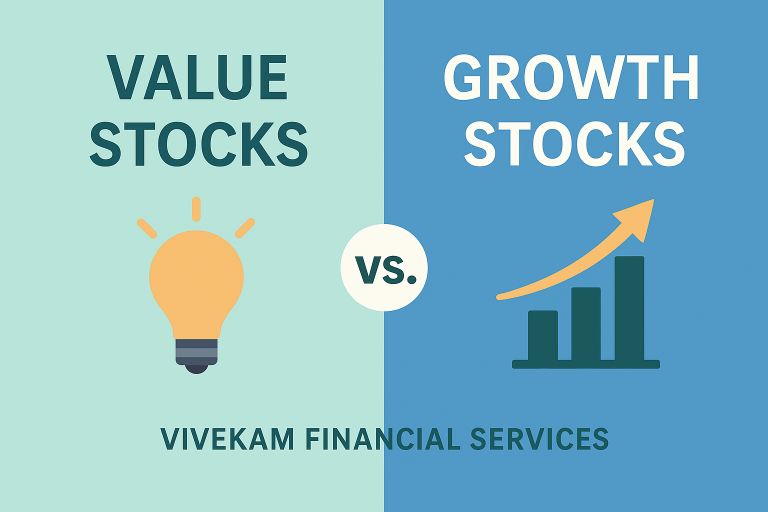Value Stocks vs Growth Stocks: What Sets Them Apart?

Understanding the battle between value stocks vs growth stocks is more than an academic exercise — it’s one of the core choices that shapes your entire investment journey. Whether you’re drawn to the calm reliability of value investing or the high-flying excitement of growth investing, knowing the differences helps you make smarter, more confident decisions.
Understanding the Basics of Value vs Growth Investing
The terms get thrown around constantly, but few people break down what they truly mean. At a high level, the debate between value vs growth investing is simply a debate between buying what’s cheap versus buying what’s growing.
What Are Value Stocks? (Value Stock Definition)
value stock is a company trading for less than what analysts believe it’s truly worth. Think of it as a solid business temporarily overshadowed by market noise — not a failing company, just one the market is mispricing.
Key Characteristics of Value Stocks
Value stocks often display metrics that scream “undervalued”:
- Lower P/E ratios compared to their peers
- Consistent dividends
- Predictable revenue streams
- Strong cash flow
- Temporary negative sentiment or overlooked business models
These companies might not be flashy, but they’re reliable — the financial equivalent of a dependable old pickup truck.
Common Industries and Market Behavior of Value Stocks
Value stocks commonly live in more mature sectors:
- Financials
- Utilities
- Industrials
- Energy
- Consumer goods
They shine when markets shift from hype to fundamentals, especially during recoveries.
What Are Growth Stocks? (Growth Stock Definition)
A growth stock represents a company pushing aggressively into the future. These businesses reinvest profits, scale rapidly, and disrupt industries.
Core Traits of Growth Stocks
Growth stocks love:
- High revenue expansion
- Premium valuations (sometimes very premium)
- Little to no dividends
- Innovation-driven business models
- Investor optimism
If value stocks are pickup trucks, growth stocks are high-performance electric supercars.
Typical Sectors and Price Patterns of Growth Stocks
Growth-focused firms often dominate:
- Technology
- Cloud computing
- Biotech
- Artificial intelligence
- Renewable energy
Their prices can shoot up fast — and drop just as quickly when the market loses confidence.
Value Investing: How It Works and Who It Fits
Value investing appeals to people who prefer a calm, patient, fundamentals-first approach. It’s built on the belief that markets eventually correct themselves.
Fundamental Principles Behind Value Investing
Value investors commonly:
- Hunt for underpriced companies
- Analyze financial statements deeply
- Prioritize safety and long-term potential
- Avoid hype-driven trends
- Focus on intrinsic value
Metrics Used in Value Stock Analysis
They rely heavily on:
- P/E ratio
- P/B ratio
- Dividend yield
- Debt-to-equity ratio
- Free cash flow
Pros and Cons of Value Investing
Pros:



Cons:
✘ Value traps exist
✘ Requires patience
✘ Undervaluation can last years
Growth Investing: Strategies, Benefits, and Risks
Growth investing is for those who want to back the next market leaders early.
Growth Investing Explained
Growth investors look for:
- Rapidly scaling companies
- Strong product-market fit
- Large addressable markets
- Future earnings potential
Financial Indicators for Analyzing Growth Stocks
Common signals include:
- Double-digit revenue growth
- Expanding profit margins
- EPS acceleration
- Elevated R&D budgets
- High customer acquisition
Advantages and Drawbacks of Growth Investing
Advantages:



Drawbacks:
✘ Higher volatility
✘ Expensive valuations
✘ Sensitive to interest rates and economic slowdowns
Growth vs Value Stocks: Core Differences and Similarities
The conversation around growth vs value stocks isn’t a battle of “good vs bad” — it’s a comparison of styles.
Side-by-Side Comparison of Value vs Growth Investing
Feature | Value Stocks | Growth Stocks |
Price Level | Low relative to earnings | High relative to earnings |
Dividends | Often high | Often none |
Risk | Lower | Higher |
Ideal Conditions | Recoveries, bear markets | Bull markets |
Investor Type | Conservative | Aggressive |
Risk Profile Differences
Growth stocks carry more risk because expectations are already priced in. Value stocks carry the risk of being misjudged by the market.
Performance Across Market Cycles
- Growth leads in booming markets
- Value leads in recoveries and downturns
Investor Psychology and Market Sentiment
Growth investors lean toward optimism; value investors lean toward skepticism and patience.
How to Choose Between Value Stocks vs Growth Stocks
Matching Investment Style with Risk Tolerance
- If you want stability → value investing
- If you want fast expansion → growth investing
Blended Strategies Combining Growth and Value
Many investors smartly combine both to capture growth while maintaining stability.
Real-World Examples of Growth and Value Stocks
Popular Growth Stocks
- NVIDIA
- Snowflake
- MercadoLibre
- CrowdStrike
Popular Value Stocks
- PepsiCo
- Pfizer
- Berkshire Hathaway
- Verizon
FAQs About Growth vs Value Stocks
- Which is better: value stocks or growth stocks?
Neither. Their success depends on market cycles. - Are value stocks safer?
Generally, yes — but not always. - Do growth stocks always outperform?
Only during expansion periods. - How do I identify each type?
Check valuation, revenue growth, and sector. - Can companies switch categories?
Absolutely. Growth companies often become value companies later. - What’s best for beginners?
Balanced exposure to both is often the safest start.
Conclusion
Deciding between Value Stocks vs. Growth Stocks: What Sets Them Apart? isn’t about picking sides — it’s about aligning your strategy with your goals. When used together, both can strengthen your long-term portfolio and help you navigate every type of market environment.







